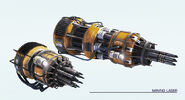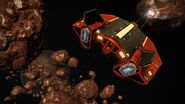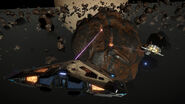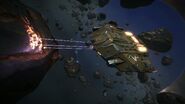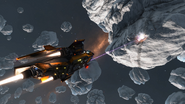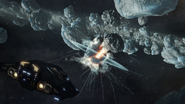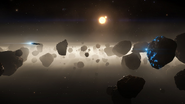(→Mining Changes: - it's important to remember that mining lasers aren't going away. the basics remain the same.) |
(→Equipment: added Upcoming content info of Beyond Chapter Four) Tag: Visual edit |
||
| Line 15: | Line 15: | ||
Some players prefer small, nimble ships for mining, as they are better at maneuvering around asteroids, in tight asteroid belts and rings at higher velocities. However others prefer the larger ships such as the [[Python]], [[Imperial Clipper]], [[Federal Corvette]], [[Imperial Cutter]] and the [[Anaconda]], which are not as maneuverable, but can equip all the beneficial [[Limpet Controller|limpet controllers]] and carry a large number of limpets for their use, while still having room for cargo and shields, increasing efficiency. Additionally, the larger ships are better at defending themselves from pirates while mining. The only major downside to using larger ships is their slower velocities and slower maneuvering. |
Some players prefer small, nimble ships for mining, as they are better at maneuvering around asteroids, in tight asteroid belts and rings at higher velocities. However others prefer the larger ships such as the [[Python]], [[Imperial Clipper]], [[Federal Corvette]], [[Imperial Cutter]] and the [[Anaconda]], which are not as maneuverable, but can equip all the beneficial [[Limpet Controller|limpet controllers]] and carry a large number of limpets for their use, while still having room for cargo and shields, increasing efficiency. Additionally, the larger ships are better at defending themselves from pirates while mining. The only major downside to using larger ships is their slower velocities and slower maneuvering. |
||
| − | == |
+ | ==Mining Ships== |
* [[Ships]] |
* [[Ships]] |
||
** A great choice for starting miners is the [[Cobra MkIII]], due to the size of its cargo hold, internal compartments, and its maneuverability. It can also fit the Class 2 mining laser. |
** A great choice for starting miners is the [[Cobra MkIII]], due to the size of its cargo hold, internal compartments, and its maneuverability. It can also fit the Class 2 mining laser. |
||
| Line 21: | Line 21: | ||
** The [[Keelback]] can equip multiple lasers and has a half-decent capacity, and can use a fighter hanger for self-defense. |
** The [[Keelback]] can equip multiple lasers and has a half-decent capacity, and can use a fighter hanger for self-defense. |
||
** The [[Type-9 Heavy|Type-9]] is fantastic for the role; the bottom medium hardpoint rarely sees use in combat so is generally fine to swap for a class 2 mining laser. Meanwhile, it can have tons of space or have massive amounts of collector limpets at once; and can even do a fantastic job defending itself with the two top mounted turret hardpoints and a fighter bay. Beware that its large size means it is virtually impossible to gather ore manually so if you don't have any limpets left, you will be forced to abandon any remaining fragments. |
** The [[Type-9 Heavy|Type-9]] is fantastic for the role; the bottom medium hardpoint rarely sees use in combat so is generally fine to swap for a class 2 mining laser. Meanwhile, it can have tons of space or have massive amounts of collector limpets at once; and can even do a fantastic job defending itself with the two top mounted turret hardpoints and a fighter bay. Beware that its large size means it is virtually impossible to gather ore manually so if you don't have any limpets left, you will be forced to abandon any remaining fragments. |
||
| + | |||
| + | == Equipment == |
||
* [[Mining Laser]] |
* [[Mining Laser]] |
||
** Required to extract the ore fragments from an asteroid. |
** Required to extract the ore fragments from an asteroid. |
||
| Line 39: | Line 41: | ||
** These require limpets to work (Purchase limpets at any restock service). They are stored in your cargo holds. |
** These require limpets to work (Purchase limpets at any restock service). They are stored in your cargo holds. |
||
** Generally, any size will do, even class 2 or 3. You won't need more than 2 or so active at once. |
** Generally, any size will do, even class 2 or 3. You won't need more than 2 or so active at once. |
||
| + | ** In the new Analysis Mode, if a Commander fires a Prospecting Limpet at an asteroid, you will be able to see the highlighted location of all the deposits on it, making it easy for you to target and exploit those specific areas. |
||
| + | |||
| + | {{upcoming}} |
||
| + | |||
| + | * [[Detailed Surface Scanner]] |
||
| + | ** Aside from mapping the surfaces of planets, the Detailed Surface Scanner can also be used to identify mineral hotspots within planetary rings. Commanders can fire probes into the rings, which will then clearly display the areas worth investigating on your screen.<ref name=":0">https://forums.frontier.co.uk/showthread.php/454587-Content-Recap-Beyond-Chapter-Four-Livestream-Mining-and-Squadrons</ref> |
||
| + | |||
| + | * [[Pulse Wave Analyser]] |
||
| + | ** Upon arrival within a ring, firing this module will send out a pulse of energy that will highlight any asteroids that have lucrative deposits on them.<ref name=":0" /> |
||
| + | |||
| + | * [[Abrasion Blaster]] |
||
| + | ** A new hardpoint module with which Commanders can shoot at '''[[Surface Deposit|Surface Deposits]]''', breaking them off for collection. Whether you do it manually, using the cargo scoop, or with limpets, you'll be able to collect the resources at your leisure.<ref name=":0" /> |
||
| + | |||
| + | * [[Sub-surface Displacement Missile]] |
||
| + | ** This new [[hardpoint]] [[module]] is used for harvesting [[Sub-surface Deposits]]. Described as a 'drill on the end of a missile', this digs in to the rock at the point of impact. The cockpit interface will then show the displacement missile travelling through the rock. Holding down the trigger and releasing at a the optimal time displayed by the interface will allow you to recover valuable sub-surface minerals.<ref name=":0" /> |
||
| + | |||
| + | * [[Seismic Charge Warhead]] |
||
| + | ** Certain asteroids, as identified by the [[fissures]] discovered on their surface, can be completely broken apart to reveal a treasure trove of resources. Commanders will place Seismic Charges within the fissures at a particular charge level.<ref name=":0" /> |
||
| + | |||
| + | ** The cockpit interface will give you an idea of how much destructive power the charges will hold, and Commanders will have to be careful to not go too far above or below that threshold, at the risk of losing valuable materials.<ref name=":0" /> |
||
| + | ** A countdown for all the charges will display on screen, so Commanders are limited on the amount of time they have to set up the perfect controlled explosion.<ref name=":0" /> |
||
| + | ** These charges can also be detonated sooner by the Commander if desired.<ref name=":0" /> |
||
==Locations== |
==Locations== |
||
Revision as of 02:08, 4 November 2018
Mining in Elite Dangerous is a very manual process; the player must use a mining laser to chip off pieces of an asteroid, which are then scooped up or collected with a drone to be refined on-board. As time-consuming as it is, miners with the right technique can make just as much money as they would in other professions.
To mine, the player must have a ship equipped with a Mining Laser and a Refinery. Cargo Racks are important to store the refined minerals and metals. Drones are recommended to improve efficiency. A detailed guide to the process can be found below.
It is recommended that players obtain system data from the Universal Cartographics, or Navigation Beacon in order to determine what asteroids are mineral rich and as close to "pristine" condition as possible to ensure a large profit.
Some players prefer small, nimble ships for mining, as they are better at maneuvering around asteroids, in tight asteroid belts and rings at higher velocities. However others prefer the larger ships such as the Python, Imperial Clipper, Federal Corvette, Imperial Cutter and the Anaconda, which are not as maneuverable, but can equip all the beneficial limpet controllers and carry a large number of limpets for their use, while still having room for cargo and shields, increasing efficiency. Additionally, the larger ships are better at defending themselves from pirates while mining. The only major downside to using larger ships is their slower velocities and slower maneuvering.
Mining Ships
- Ships
- A great choice for starting miners is the Cobra MkIII, due to the size of its cargo hold, internal compartments, and its maneuverability. It can also fit the Class 2 mining laser.
- The Adder is also the earliest ship capable of efficient mining as it can equip three mining lasers and has decent capacity but won't be able to defend itself.
- The Keelback can equip multiple lasers and has a half-decent capacity, and can use a fighter hanger for self-defense.
- The Type-9 is fantastic for the role; the bottom medium hardpoint rarely sees use in combat so is generally fine to swap for a class 2 mining laser. Meanwhile, it can have tons of space or have massive amounts of collector limpets at once; and can even do a fantastic job defending itself with the two top mounted turret hardpoints and a fighter bay. Beware that its large size means it is virtually impossible to gather ore manually so if you don't have any limpets left, you will be forced to abandon any remaining fragments.
Equipment
- Mining Laser
- Required to extract the ore fragments from an asteroid.
- Higher class lasers may extract ore fragments faster.
- Multiple lasers may also be equipped but will draw more power in total, and will also mean you have fewer hardpoints to defend yourself as they are incredibly inefficient at dealing damage and have the lowest range in the game.
- The Mining Lance offers far greater range and is capable of dealing 8 DPS, instead of 2, only slightly less than the 1E Beam Laser. The downsides are the higher power draw and the huge amount of thermal load generated.
- Refinery
- Required to process the collected ore.
- Better refineries have up to ten bins to process several types of ore simultaneously.
- Collector Limpet
- Automated collection massively improves profit per hour by collecting fragments automatically.
- Limpets have a set lifetime and will automatically collect items with no user input required.
- Limpets need to be individually purchased at munition store (in the advanced maintenance tab) for 101 credit each limpet and will occupy your cargo rack (1T for each limpet).
- The number of collector limpet modules on each ship is not limited to one, and installing more than one limpet module increases the max number of active limpet at a time, thus increasing collection efficiency. If you have space to install 2 class 5 collector limpet modules, for instance, you may have 6 collector limpets active simultaneously.
- Prospector Limpet
- Prospecting allows miners to view the mineral content of an asteroid even from a distance.
- Prospecting asteroids before mining results in double yield.
- These require limpets to work (Purchase limpets at any restock service). They are stored in your cargo holds.
- Generally, any size will do, even class 2 or 3. You won't need more than 2 or so active at once.
- In the new Analysis Mode, if a Commander fires a Prospecting Limpet at an asteroid, you will be able to see the highlighted location of all the deposits on it, making it easy for you to target and exploit those specific areas.
 |
Upcoming Content
Content presented on this page has not been released yet. Details are subject to change before release, and anything unsupported by a source may be speculation or incorrect. |
- Detailed Surface Scanner
- Aside from mapping the surfaces of planets, the Detailed Surface Scanner can also be used to identify mineral hotspots within planetary rings. Commanders can fire probes into the rings, which will then clearly display the areas worth investigating on your screen.[1]
- Pulse Wave Analyser
- Upon arrival within a ring, firing this module will send out a pulse of energy that will highlight any asteroids that have lucrative deposits on them.[1]
- Abrasion Blaster
- A new hardpoint module with which Commanders can shoot at Surface Deposits, breaking them off for collection. Whether you do it manually, using the cargo scoop, or with limpets, you'll be able to collect the resources at your leisure.[1]
- Sub-surface Displacement Missile
- This new hardpoint module is used for harvesting Sub-surface Deposits. Described as a 'drill on the end of a missile', this digs in to the rock at the point of impact. The cockpit interface will then show the displacement missile travelling through the rock. Holding down the trigger and releasing at a the optimal time displayed by the interface will allow you to recover valuable sub-surface minerals.[1]
- Seismic Charge Warhead
- Certain asteroids, as identified by the fissures discovered on their surface, can be completely broken apart to reveal a treasure trove of resources. Commanders will place Seismic Charges within the fissures at a particular charge level.[1]
- The cockpit interface will give you an idea of how much destructive power the charges will hold, and Commanders will have to be careful to not go too far above or below that threshold, at the risk of losing valuable materials.[1]
- A countdown for all the charges will display on screen, so Commanders are limited on the amount of time they have to set up the perfect controlled explosion.[1]
- These charges can also be detonated sooner by the Commander if desired.[1]
Locations
Mining is currently possible at asteroid belts or planetary rings (including icy as of 2.1/1.6), although it is the most profitable in a Pristine Metallic area. They can be targeted and flown to in supercruise, just like any destination within a system. Marked extraction sites can only be seen at ranges of 1kls or closer. Asteroids in planetary rings can also be mined from - RES are common places for NPC miners to congregate in, but pirates will also spawn here.
Mining is not limited to extraction sites, which is much safer since there is virtually no NPCs spawning outside them. Flying at any part of a ring system at less than 1Mm/s will result in a safe drop approximately 7km away from the ring. It is important, however, to identify the metallic rings before attempting this. When you have arrived, you will see a number (from a handful to many dozens) of asteroids, which you can then mine. A good starting spot for mining are systems with industrial economies.
Mining Locations change in both quality and quantity which when presented one through five, one being the highest and five being the lowest are currently;
- Pristine
- Major
- Common
- Low
- Depleted
This information can be found in the system map by targeting either the belt cluster or planet of interest. Planetary rings are labeled from inner to outer with descending letters starting from A.
Locations of planets with pristine metallic rings can be found here and on Pristine Metallics Distances Calculator site, screenshots of many of those systems listed are here .
Guide
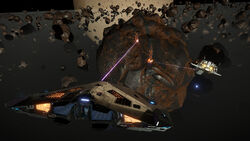
Mining duo
Mining involves three main steps:
- Fragmenting
- Collecting
- Refining
It is important to note that these steps will generally be happening all at the same time. The technique involves managing all three steps at once to maximize efficiency.
Fragmenting
Make sure to bind a Mining Laser (preferably in its own firing group) just like you would do with any other weapon in the game. Fly within range (being 500 m) of the asteroid and blast away with the Mining Laser. You have to hold down the trigger for a while (depending on the quality of Mining Laser you have bought) before a fragment chips off.
Select the fragment of rock as a target. They are quite small and hard to detect visually but do show up as white contacts on your radar. When selected, you get details of the contents of the fragment, e.g. Bauxite (9.7%) Coltan (21.2%). Note that the mineral name which shows up first in the HUD doesn't necessarily represent the most valuable mineral! The mineral content is how much of a ton of cargo can be extracted from the fragment. E.g. if you scoop and process three 35% Indite shards you end up with 1 ton of Indite. Fragments range in mineral content from ~5% to ~65%. Asteroids contain 1 to 3 different minerals while fragments from the asteroids contain up to 2 of those minerals.
Probing
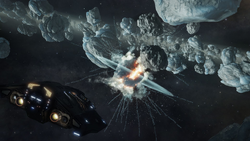
Python mining asteroid explosion
Coming with Elite Dangerous: Beyond Chapter Four: using new tools and exploration mechanics, miners can investigate rings to locate the best spots to start their mining sessions, and then the best specific asteroids to probe and excavate for rewards. With the right amount of skill and expertise, the new Abrasion blaster, Sub-surface displacement missile, and Seismic charge launcher, will provide some exciting and explosive results.[2]
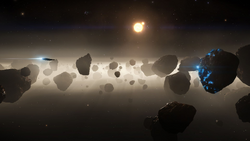
Asteroid probe
Collecting
Collecting fragments can be done with a cargo scoop or a collector limpet drone.
To collect with a cargo scoop, first, engage your scoop (just like you would with your landing gear or hardpoints), then fly slowly towards the target. Upon engaging the Cargo Scoop you will find that a blue box will have appeared on the lower left of your HUD. On there you should, if pointing at the rock, see an icon in the cross-hairs (the box). Continue to fly slowly towards the rock while holding the rock in the middle of the cargo scoop's cross-hairs until you have successfully acquired it.
Asteroid fragments are more difficult to scoop than regular cargo, as their movement is more complex (not to mention the fact that you want to avoid hitting an asteroid while you're focused on scooping!) For this reason, it's advisable to use very slow speeds of 15 m/s while scooping. Furthermore, fragments will "decay" over time, meaning they slowly lose integrity until they disappear, so do not mine more than you can collect!
To collect with a collector limpet controller you must purchase limpets ahead of time in any munitions store (the place you buy your ammo). Collector limpets have 2 modes: quick single-collection and autonomous area-collection. For mining, the area-collection mode is optimal. Limpets must bound to a fire group like a weapon.
To activate a limpet in area mode, be sure that no cargo or fragment is targeted. This is important as activating a limpet with a collectible item targeted will activate the limpet in single-collection mode. Once in area mode, the limpet will automatically collect any fragments a specific distance from you based on the class and rating of the controller. While this happens you can continue with other actions such as fragmenting, refining, and monitoring your surroundings. Use collector drones with caution near spinning asteroids, since their basic AI doesn't account for the movement of the asteroid. You can equip multiple collector drone limpet controls assuming you have enough internal compartments.
Refining
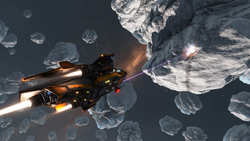
Diamondback mining
Once a fragment enters your cargo hold, it will be deposited in the refinery. It can be accessed on the left panel of the cargo screen. The first bin is the depositing bin, where you will find your fragment. New minerals will attempt to drop into the refinery bins below. Depending on class your refinery will have between 1 and 10 of these bins.
Items that appear in the depositing bin will automatically "stack" into the refinery bins below if a refinery bin that already contains that mineral exists. It will also drop into empty bins automatically. If no bin is available, you will have to vent your refinery (see next paragraph). This will happen until the bin reaches 100% at which point it will be emptied, the leftover mineral will remain in the depositing bin, and 1 ton of cargo (one unit of whatever mineral you have collected) appears in your cargo hold. Once your cargo hold is full, you can return to a station and sell your goods.
You also have the option to "vent" the contents of your refinery. This is useful if you have a nearly-full refinery of bauxite and you find an asteroid with gold (or whatever else you prioritize). When no bin is available, minerals will not leave the depositing bin and will block it from accepting new fragments. When this happens you must either vent a refinery bin to free up space or vent the mineral from the depositing bin. NOTE: Doing this will destroy the mineral and you will not be able to recover it.
Availability and Value
This is a rough table on which minerals, metals, and chemicals are most valuable to mine. These prices will be lower or higher depending on demand in the station you're selling to. It can be helpful to screenshot the nearest station's metal, mineral and chemical market prices to ensure highest profit, since varying demand of different resources can result in great variation of profit.
| Minerals | Galactic Average Price (CR/T) | Available in Ring Type |
|---|---|---|
| Low Temperature Diamond | 57443 | Icy |
| Painite | 40504 | Metallic |
| Bromellite | 8530 | Icy |
| Lithium Hydroxide | 5644 | Icy |
| Bertrandite | 2375 | Metallic, Metal Rich |
| Methanol Monohydrate Crystals | 2282 | Icy |
| Indite | 2088 | Metallic, Metal Rich, Rocky |
| Gallite | 1821 | Metallic, Metal Rich, Rocky |
| Coltan | 1319 | Metal Rich, Rocky |
| Uraninite | 836 | Metal Rich, Rocky |
| Methane Clathrate | 629 | Icy |
| Lepidolite | 544 | Metal Rich, Rocky |
| Rutile | 299 | Rocky |
| Bauxite | 120 | Rocky |
| Metals | Galactic Average Price (CR/T) | Available in Ring Type |
| Platinum | 19756 | Metallic |
| Palladium | 13295 | Metallic |
| Gold | 9401 | Metallic, Metal Rich |
| Osmium | 9136 | Metallic, Metal Rich |
| Praseodymium | 8604 | Metallic, Metal Rich |
| Samarium | 8090 | Metallic, Metal Rich |
| Silver | 4777 | Metallic, Metal Rich |
| Cobalt | 648 | Rocky |
| Chemicals | Galactic Average Price (CR/T) | Available in Ring Type |
| Hydrogen Peroxide | 917 | Icy |
| Liquid Oxygen | 263 | Icy |
| Water | 120 | Icy |
Selling
The value of a mineral is scaled to the supply/demand meaning that selling minerals where there are many other players selling the same mineral will result in a smaller profit per ton as demand for that item is low with so many suppliers. Systems that are both refinery economies and have an asteroid field will tend to give you a lower price compared to what you would get if you were to travel somewhere more distant to the source (source being asteroid fields). Also, checking the bulletin board is very important, since mining mission rewards can reach hundreds of thousands of credits. The most sought-after minerals in missions are painite, osmium and platinum.
Accepting Mining contracts at the Mission Board yields much more money for the mined commodities.
Styx is an excellent example of where we see a massive drop in prices. It has both mining equipment for sale, is very close to the spawn point for new players, has mineable asteroid fields and is a refinery economy (means it will have a constant demand for minerals to refine), it is therefore going to be very popular to sell minerals there which is going to lead to a price drop due to a saturated market.
Keep in mind that carrying valuable resources around attracts pirates and other players may also try to rob you. With mining lasers attached you will be less effective at defending yourself so don't lug rare metals around too long.
Materials
This is a rough guide to which materials are available to mine.
| Class I | Class II | Class III | Class IV |
| Carbon | Chromium | Arsenic | Cadmium |
| Iron | Germanium | Niobium | Mercury |
| Lead | Manganese | Selenium | Molybdenum |
| Nickel | Vanadium | Tungsten | Tin |
| Phosphorus | Zinc | Zirconium | Boron |
| Rhenium | |||
| Sulphur |
Frequency: I (very common) > II (common) > III (standard) > IV (rare)
Pirates and other miners
Pirates can be a problem. They occasionally do a fly-by and scan you. They might even attack. You can prepare for this eventuality in several different ways:
- If you have brought some defensive weaponry of your own it may be possible to turn the tables on your would-be attacker, earning yourself a bounty payout in the process. Of course, rigging your ship for combat might reduce your cargo space, so you would have to travel a lot more between your mining site and the station every time your cargo hold is full.
- Jumping away into supercruise or hyperspace is also an option if you find yourself outmatched, although it might be frustrating having to abandon valuable asteroids you may have discovered. It is also important to remember that asteroid rings establish a mass-locking effect on your frame shift drive, necessitating that you clear the asteroid field to a sufficient distance before your FSD will begin charging. Asteroid belt clusters will not lock your FSD, but retain enough local mass to disrupt low-energy jumps. It is also necessary to align towards a sensible escape vector before your computer will engage the jump.
- If you're in a system controlled by a non-anarchic faction, resource extraction sites are often patrolled by security forces mobilized to defend miners and engage any wanted ships they detect. Ensure your ship's computer is set to 'report crimes committed against me' to enable a swift security response.
- Additional tip - You can mine planetary rings anywhere, even completely outside a Resource Extraction Site (RES)- just get close in supercruise, then lower your speed to minimum before hitting the ring. Hitting the ring at this speed will cause you to drop out of supercruise at the ring with no damage although you will not have police protection (usually). Alternatively, in a RES, fly 30 or more km away from the RES marker. You will not see any NPCs spawn again unless you go closer. It does not seem to make any difference to the quality of rocks you mine.
- If your ship has the option a Fighter Hanger can be a good option for defense since most of your hardpoints will be being used on mining lasers. Simply deploy a fighter as soon as you arrive and use it or order a crewmember to defend yourself. This could make the Keelback a decent early option, but its low cargo space with a fighter bay may prove an issue.
It's kind of a dirty trick, but if you see other NPC miners out there zapping away, it's usually worth it to mine the rock they're currently working on. They seem surprisingly good-natured about you grabbing their spot, even. Be careful not to accidentally shoot or crash into them however as you may provoke them; or gain a bounty.
Tips
- Asteroid fragments will display on the ship's radar as grey boxes.
- Use the System Map to find systems with asteroid belts or rings that have the description "Pristine Reserves" and "Metallic".
- Mining in planetary rings is more effective as there are always plenty of nearby asteroids to choose from (unlike belts).
- For maximum profit, focus on mining highly valued metals or minerals (like Painite, Platinum, Palladium or Low Temperature Diamonds).
- Use collector drones to speed up efficiency.
- Use prospector drones to double the yield of asteroid fragments.
- If the asteroid's fragments have low concentration (below ±15%), don't waste your precious time and try a different one.
- Even if your cargo is full, you can still fill up the refinery to 100% per slot. When you return to a starport to sell your cargo, this frees up space and each full refinery slot will go into your cargo hold. Treat it as extra cargo space.
- Planets create massive shadows. Be sure to avoid mining in the shadow of the planet or turn up your gamma.
- The material content (Low, Medium, High) does not affect the amount of metals, minerals or chemicals that the asteroid contains.
- Keep an eye on the fragments; in some cases, they will get themselves stuck inside the meteorites. This will make it so your collector limpets will launch themselves into the rock; destroying themselves. If you notice a drone die early quickly look out for this and add it to your exclusion list as soon as possible to avoid more limpet loses.
- You can craft additional limpets via synthesis and you are very likely to pick up the components for them while mining; however they are incredibly wasteful of Nickel, which is a common engineering material. Use this only in a pinch such as seeing rare materials with no drones.
- If you are only mining for access to Selene Jean's engineering then always go to planetary rings. You can still use prospector drones to increase yield but you will be instead looking for group asteroids so you can collect as much as possible as fast as possible as you generally won't be too concerned with profit in this scenario. In fact, more common ores may be desirable due to being able to refine them faster. Use as many collector limpet controllers as you can equip with as big of a refinery as possible as well to help out.
Trivia
- Added in the Beta 3 Update which went live on October 28th, 2014.
News
30 OCT 3300 GalNet News: Mining Special report! According to the experts at Wreaken Construction and Mining, all you need is a refinery, a mining laser and a little luck. Most rings in known space are depleted but for the individual there is still some money to be made. The Current equipment is not configured to work with ice rings and the best yields will be found on metal rings far from populated space. Our contacts at Stellar Cartographics, James Urquhart, was keen to point out that data is available in any of the mapped systems, showing both the type of ring/belt and the level of reserves. Reserves have been categorised from Depleted to Pristine and the belt composition comes under one of four types.
— In-Game Galnet News
Mining Changes
Beyond Chapter Four will build upon current mining systems by adding a series of specialized tools that allow experienced miners to wring more profit from the belts.
Existing mining lasers will remain relevant as an 'entry level' option for mining, but pilots looking to make as much money as possible may wish to invest in these advanced tools.
Here are two comparison videos of how mining worked before and after the major update.

